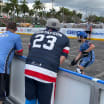SAN JOSE -- The recipe for success that resulted in the Pittsburgh Penguins lifting the Stanley Cup on Sunday, no doubt, would not work without heavy doses of Sidney Crosby, Evgeni Malkin, Phil Kessel and Kris Letang.
That core of talent is one few opponents can match, but the Penguins' mix wasn't quite right until Mike Sullivan was brought in to coach them on Dec. 12 and implemented a relentless speed and pressure game that fit their personnel perfectly. After going 33-16-5 under Sullivan during the regular season, they rolled into the Stanley Cup Playoffs as the NHL's hottest team and overwhelmed the New York Rangers, Washington Capitals, Tampa Bay Lightning and, finally, the San Jose Sharks on the way to their fourth championship.
Penguins win Cup with speed, pressure
Teams could try to build same formula this summer, beyond

It culminated with a 3-1 victory against the Sharks in Game 6 of the Cup Final on Sunday that had co-owner Mario Lemieux, a Hockey Hall of Fame member and two-time Cup champion as a player, crediting Sullivan with changing the way the Penguins play and, possibly, how teams throughout the League will try to win going forward.
"We play a fast game. We play with a lot of pressure," Lemieux said. "Now that we've won with speed, I think you'll see a lot of teams changing the way they play now."
Professional sports leagues often produce copycats in the pursuit of championships, and the NHL is no different. After the Anaheim Ducks won the Cup in 2007 with a combination of skill, size and toughness, that became the trend. The Boston Bruins won with a similar heavy approach.
After the Los Angeles Kings won the Stanley Cup in 2012 and 2014 with their size-and-strength power game, they became the team some tried to emulate, but the Penguins' success is the crowning achievement for the recent trend toward the speed game.
"I think a lot of teams are going to look at that," NHL Network analyst and former goaltender Kevin Weekes said. "I think it's harder to build a team that plays a power game the way you built L.A. and the way Boston was. It's almost easier based on today's players to build a team that plays faster, that can attack faster offensively but also can attack defensively."
When the Penguins were eliminated by the Rangers in five games in the first round of last year's playoffs, their need for speed was notable. Beginning last summer, Penguins general manager Jim Rutherford tried to address that, retooling his roster with trades for fast-skating forwards such as Kessel, Nick Bonino and Carl Hagelin, and a skilled puck-moving defenseman in Trevor Daley.
Those acquisitions were reinforced by speedy call-ups such as Conor Sheary, Bryan Rust and Tom Kuhnhackl. In less than a year, Rutherford transformed the Penguins into the fastest team in the League, playing a system that emphasizes that speed with quick breakouts, transition rushes and relentless pressure in each end of the rink.
"That was a big difference, because when you look at the teams we played, when we brought our speed that really disoriented other teams," Rutherford said. "You look at all the teams we played and they were all good teams, though the Rangers were banged up a bit injuries. But we played good teams, and I think our speed made a difference."
What also made a difference was the Penguins depth. Rather than playing his top forwards together, Sullivan took the unorthodox approach of putting Crosby, Malkin and Kessel on three different lines and complementing their world-class talents with lesser-skilled-but-speedy players.
For example, Sheary and Rust went from playing in the American Hockey League to playing and thriving alongside Crosby and Malkin on the Penguins' top two lines.
With a solid fourth line centered by veteran Matt Cullen, Sullivan rolled four lines that came at opponents in waves. It meant a little less ice time for the stars, but the payoff was big.
"I loved our balance, and that's why I think we had the ability to sustain the pace of play that we were able to play at," Sullivan said. "I thought it was our ultimate competitive advantage on our opponents."
Despite that, Rutherford doesn't believe it should lead to a League-wide abandonment of trying to win with size and strength.
"I don't think it has to be one way," Rutherford said. "Some teams can win with heavy teams. They've done it in the last couple of years. We did it with speed this year. I don't think you have to do it just one way."
Ultimately, it comes down to having a system that makes the most of the players' talent and those players buying in. The Sharks played a combination of a speed and strength game that served them well in defeating heavier teams, such as the Kings and St. Louis Blues, on their way to the Cup Final. They were also able to skate with a fast Nashville Predators team in second round. But the Penguins were just faster and deeper.
"I think teams are already starting to trend that way, so it won't be a major shift," TSN analyst and former NHL player Ray Ferraro said of the movement toward speed. "But I think it's almost like a loser's game to try to emulate somebody else, because you can't have their personnel. Yes, you can try and be fast, but unfortunately, you don't have Crosby or Malkin or Letang. When teams were trying to get really big like L.A. and Anaheim, well, that's nice, but you don't have [Anze] Kopitar and [Jeff] Carter and [Drew] Doughty.
"So, I think the game is trending that way anyway, but I always think when teams are trying to model after someone else that's a losing proposition."

















